Effective Business Communication - Annotated Bibliography
VerifiedAdded on 2022/11/24
|11
|2919
|451
AI Summary
This annotated bibliography explores the impact of interpersonal communication skills on organizational effectiveness and social self-efficacy. It discusses the importance of non-verbal communication, business communication practices from employers' perspectives, oral communication skills, communication competence in supervisor-employee relationships, characteristics and advantages of interpersonal communication, effective marketing communication via social networking sites, and the use of social media for work collaboration and team communication. The articles provide insights into the importance of effective communication in business organizations.
Contribute Materials
Your contribution can guide someone’s learning journey. Share your
documents today.
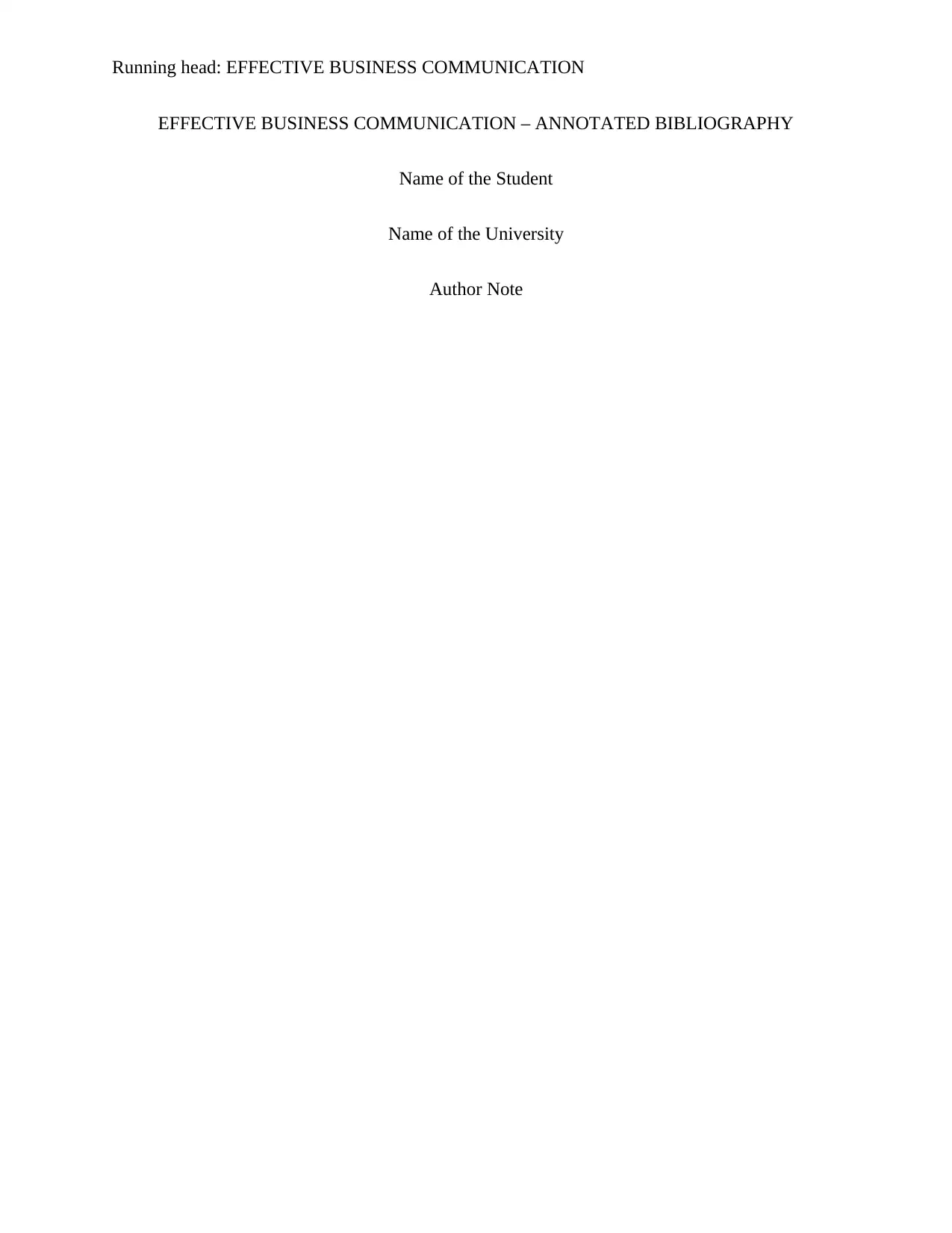
Running head: EFFECTIVE BUSINESS COMMUNICATION
EFFECTIVE BUSINESS COMMUNICATION – ANNOTATED BIBLIOGRAPHY
Name of the Student
Name of the University
Author Note
EFFECTIVE BUSINESS COMMUNICATION – ANNOTATED BIBLIOGRAPHY
Name of the Student
Name of the University
Author Note
Secure Best Marks with AI Grader
Need help grading? Try our AI Grader for instant feedback on your assignments.
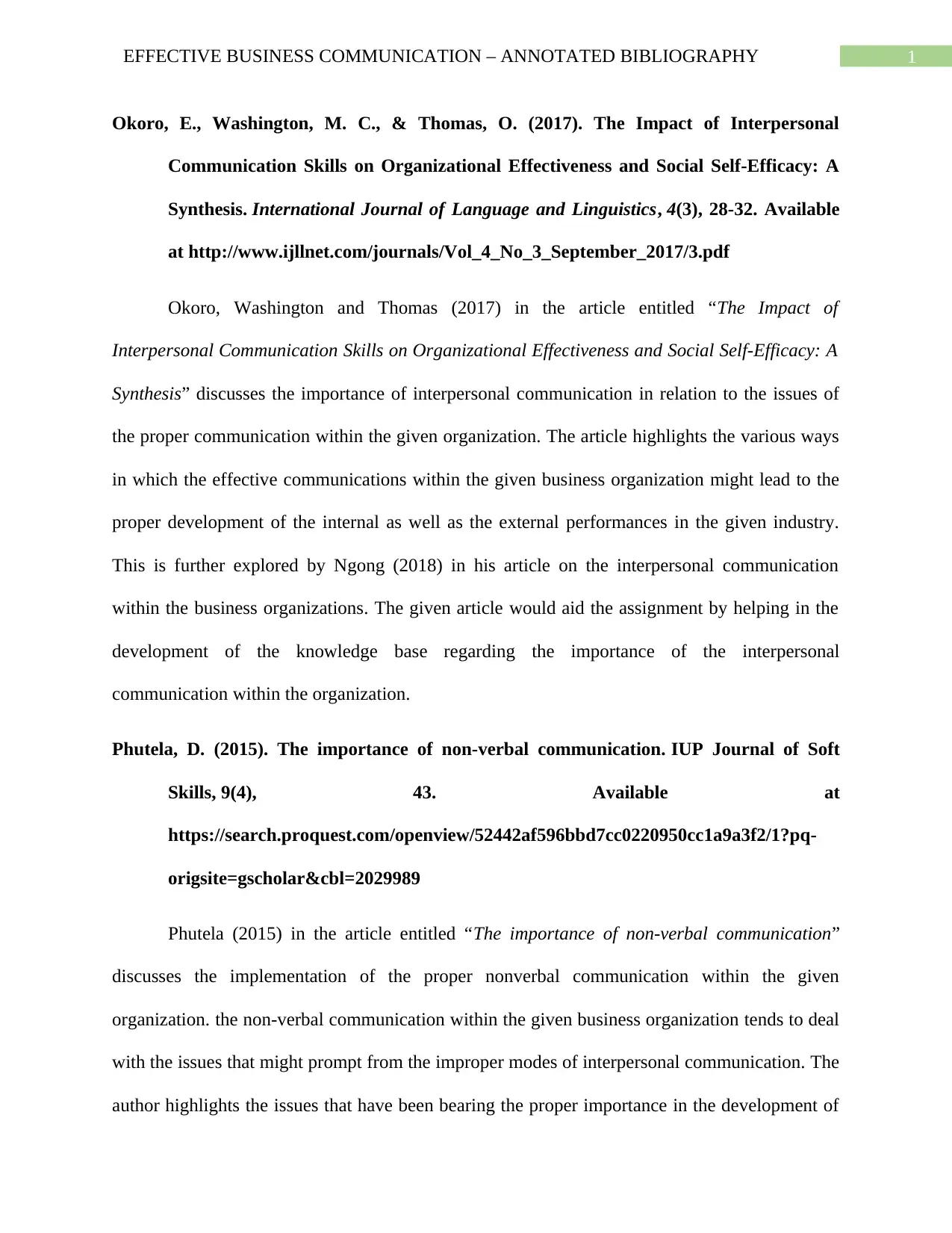
1EFFECTIVE BUSINESS COMMUNICATION – ANNOTATED BIBLIOGRAPHY
Okoro, E., Washington, M. C., & Thomas, O. (2017). The Impact of Interpersonal
Communication Skills on Organizational Effectiveness and Social Self-Efficacy: A
Synthesis. International Journal of Language and Linguistics, 4(3), 28-32. Available
at http://www.ijllnet.com/journals/Vol_4_No_3_September_2017/3.pdf
Okoro, Washington and Thomas (2017) in the article entitled “The Impact of
Interpersonal Communication Skills on Organizational Effectiveness and Social Self-Efficacy: A
Synthesis” discusses the importance of interpersonal communication in relation to the issues of
the proper communication within the given organization. The article highlights the various ways
in which the effective communications within the given business organization might lead to the
proper development of the internal as well as the external performances in the given industry.
This is further explored by Ngong (2018) in his article on the interpersonal communication
within the business organizations. The given article would aid the assignment by helping in the
development of the knowledge base regarding the importance of the interpersonal
communication within the organization.
Phutela, D. (2015). The importance of non-verbal communication. IUP Journal of Soft
Skills, 9(4), 43. Available at
https://search.proquest.com/openview/52442af596bbd7cc0220950cc1a9a3f2/1?pq-
origsite=gscholar&cbl=2029989
Phutela (2015) in the article entitled “The importance of non-verbal communication”
discusses the implementation of the proper nonverbal communication within the given
organization. the non-verbal communication within the given business organization tends to deal
with the issues that might prompt from the improper modes of interpersonal communication. The
author highlights the issues that have been bearing the proper importance in the development of
Okoro, E., Washington, M. C., & Thomas, O. (2017). The Impact of Interpersonal
Communication Skills on Organizational Effectiveness and Social Self-Efficacy: A
Synthesis. International Journal of Language and Linguistics, 4(3), 28-32. Available
at http://www.ijllnet.com/journals/Vol_4_No_3_September_2017/3.pdf
Okoro, Washington and Thomas (2017) in the article entitled “The Impact of
Interpersonal Communication Skills on Organizational Effectiveness and Social Self-Efficacy: A
Synthesis” discusses the importance of interpersonal communication in relation to the issues of
the proper communication within the given organization. The article highlights the various ways
in which the effective communications within the given business organization might lead to the
proper development of the internal as well as the external performances in the given industry.
This is further explored by Ngong (2018) in his article on the interpersonal communication
within the business organizations. The given article would aid the assignment by helping in the
development of the knowledge base regarding the importance of the interpersonal
communication within the organization.
Phutela, D. (2015). The importance of non-verbal communication. IUP Journal of Soft
Skills, 9(4), 43. Available at
https://search.proquest.com/openview/52442af596bbd7cc0220950cc1a9a3f2/1?pq-
origsite=gscholar&cbl=2029989
Phutela (2015) in the article entitled “The importance of non-verbal communication”
discusses the implementation of the proper nonverbal communication within the given
organization. the non-verbal communication within the given business organization tends to deal
with the issues that might prompt from the improper modes of interpersonal communication. The
author highlights the issues that have been bearing the proper importance in the development of
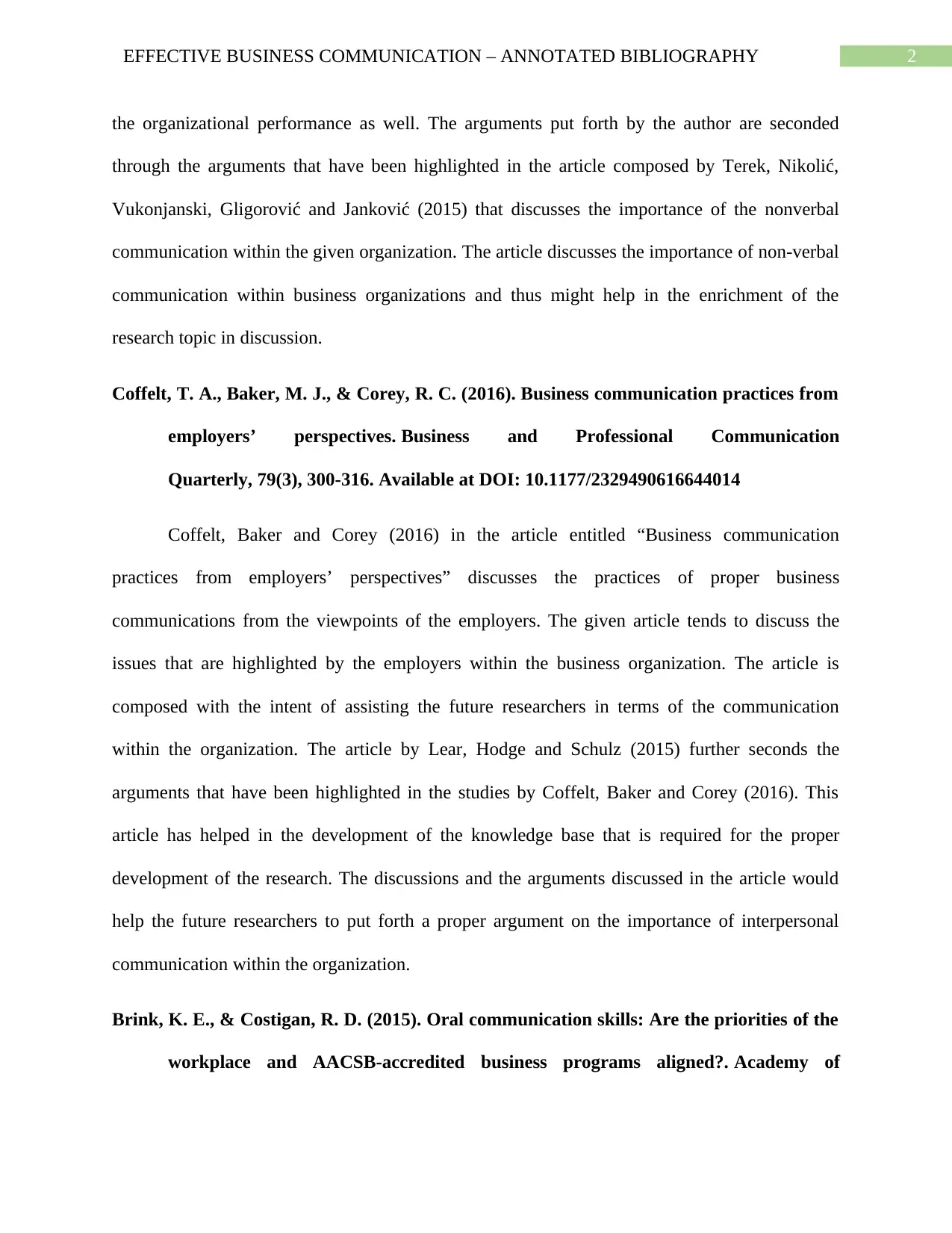
2EFFECTIVE BUSINESS COMMUNICATION – ANNOTATED BIBLIOGRAPHY
the organizational performance as well. The arguments put forth by the author are seconded
through the arguments that have been highlighted in the article composed by Terek, Nikolić,
Vukonjanski, Gligorović and Janković (2015) that discusses the importance of the nonverbal
communication within the given organization. The article discusses the importance of non-verbal
communication within business organizations and thus might help in the enrichment of the
research topic in discussion.
Coffelt, T. A., Baker, M. J., & Corey, R. C. (2016). Business communication practices from
employers’ perspectives. Business and Professional Communication
Quarterly, 79(3), 300-316. Available at DOI: 10.1177/2329490616644014
Coffelt, Baker and Corey (2016) in the article entitled “Business communication
practices from employers’ perspectives” discusses the practices of proper business
communications from the viewpoints of the employers. The given article tends to discuss the
issues that are highlighted by the employers within the business organization. The article is
composed with the intent of assisting the future researchers in terms of the communication
within the organization. The article by Lear, Hodge and Schulz (2015) further seconds the
arguments that have been highlighted in the studies by Coffelt, Baker and Corey (2016). This
article has helped in the development of the knowledge base that is required for the proper
development of the research. The discussions and the arguments discussed in the article would
help the future researchers to put forth a proper argument on the importance of interpersonal
communication within the organization.
Brink, K. E., & Costigan, R. D. (2015). Oral communication skills: Are the priorities of the
workplace and AACSB-accredited business programs aligned?. Academy of
the organizational performance as well. The arguments put forth by the author are seconded
through the arguments that have been highlighted in the article composed by Terek, Nikolić,
Vukonjanski, Gligorović and Janković (2015) that discusses the importance of the nonverbal
communication within the given organization. The article discusses the importance of non-verbal
communication within business organizations and thus might help in the enrichment of the
research topic in discussion.
Coffelt, T. A., Baker, M. J., & Corey, R. C. (2016). Business communication practices from
employers’ perspectives. Business and Professional Communication
Quarterly, 79(3), 300-316. Available at DOI: 10.1177/2329490616644014
Coffelt, Baker and Corey (2016) in the article entitled “Business communication
practices from employers’ perspectives” discusses the practices of proper business
communications from the viewpoints of the employers. The given article tends to discuss the
issues that are highlighted by the employers within the business organization. The article is
composed with the intent of assisting the future researchers in terms of the communication
within the organization. The article by Lear, Hodge and Schulz (2015) further seconds the
arguments that have been highlighted in the studies by Coffelt, Baker and Corey (2016). This
article has helped in the development of the knowledge base that is required for the proper
development of the research. The discussions and the arguments discussed in the article would
help the future researchers to put forth a proper argument on the importance of interpersonal
communication within the organization.
Brink, K. E., & Costigan, R. D. (2015). Oral communication skills: Are the priorities of the
workplace and AACSB-accredited business programs aligned?. Academy of
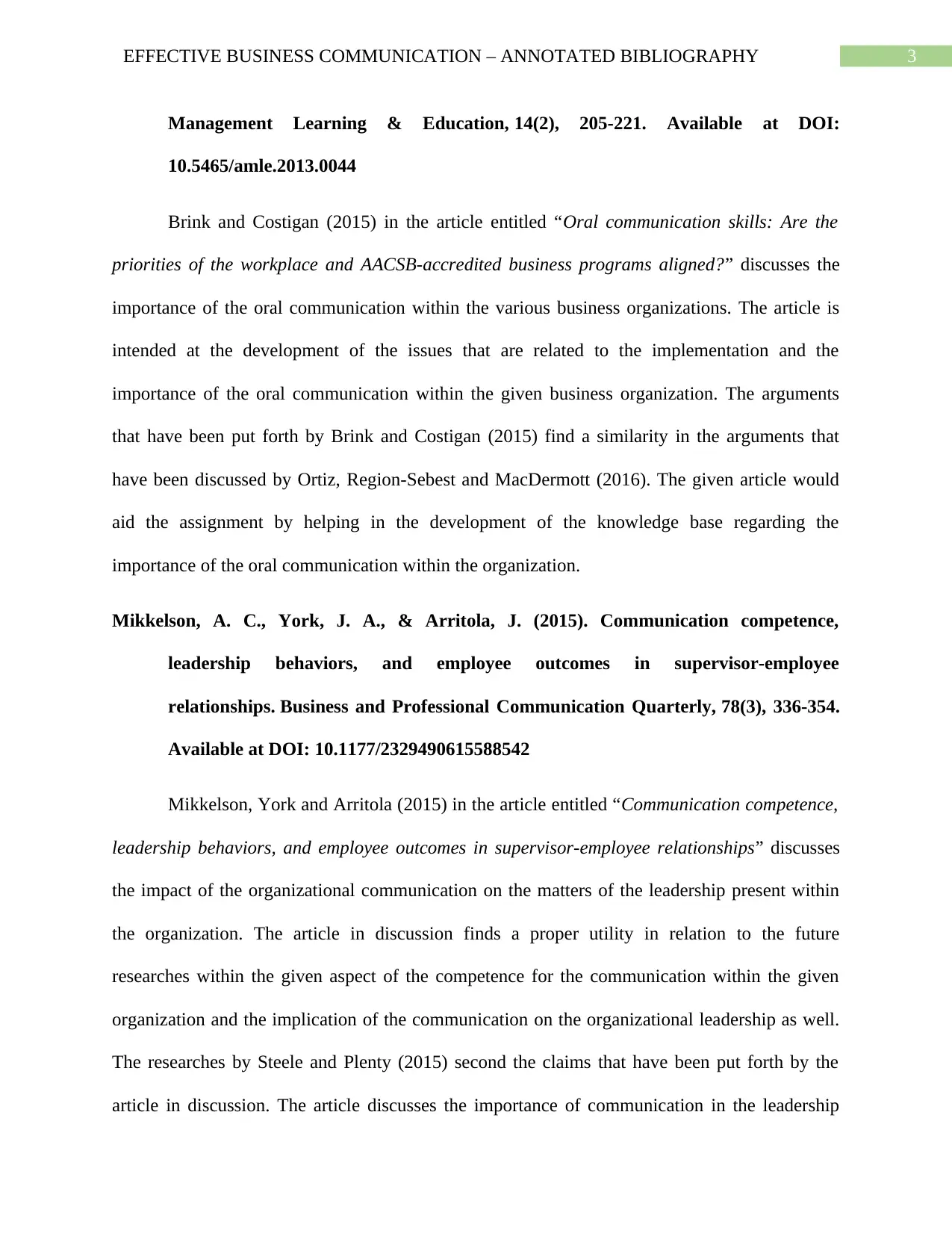
3EFFECTIVE BUSINESS COMMUNICATION – ANNOTATED BIBLIOGRAPHY
Management Learning & Education, 14(2), 205-221. Available at DOI:
10.5465/amle.2013.0044
Brink and Costigan (2015) in the article entitled “Oral communication skills: Are the
priorities of the workplace and AACSB-accredited business programs aligned?” discusses the
importance of the oral communication within the various business organizations. The article is
intended at the development of the issues that are related to the implementation and the
importance of the oral communication within the given business organization. The arguments
that have been put forth by Brink and Costigan (2015) find a similarity in the arguments that
have been discussed by Ortiz, Region-Sebest and MacDermott (2016). The given article would
aid the assignment by helping in the development of the knowledge base regarding the
importance of the oral communication within the organization.
Mikkelson, A. C., York, J. A., & Arritola, J. (2015). Communication competence,
leadership behaviors, and employee outcomes in supervisor-employee
relationships. Business and Professional Communication Quarterly, 78(3), 336-354.
Available at DOI: 10.1177/2329490615588542
Mikkelson, York and Arritola (2015) in the article entitled “Communication competence,
leadership behaviors, and employee outcomes in supervisor-employee relationships” discusses
the impact of the organizational communication on the matters of the leadership present within
the organization. The article in discussion finds a proper utility in relation to the future
researches within the given aspect of the competence for the communication within the given
organization and the implication of the communication on the organizational leadership as well.
The researches by Steele and Plenty (2015) second the claims that have been put forth by the
article in discussion. The article discusses the importance of communication in the leadership
Management Learning & Education, 14(2), 205-221. Available at DOI:
10.5465/amle.2013.0044
Brink and Costigan (2015) in the article entitled “Oral communication skills: Are the
priorities of the workplace and AACSB-accredited business programs aligned?” discusses the
importance of the oral communication within the various business organizations. The article is
intended at the development of the issues that are related to the implementation and the
importance of the oral communication within the given business organization. The arguments
that have been put forth by Brink and Costigan (2015) find a similarity in the arguments that
have been discussed by Ortiz, Region-Sebest and MacDermott (2016). The given article would
aid the assignment by helping in the development of the knowledge base regarding the
importance of the oral communication within the organization.
Mikkelson, A. C., York, J. A., & Arritola, J. (2015). Communication competence,
leadership behaviors, and employee outcomes in supervisor-employee
relationships. Business and Professional Communication Quarterly, 78(3), 336-354.
Available at DOI: 10.1177/2329490615588542
Mikkelson, York and Arritola (2015) in the article entitled “Communication competence,
leadership behaviors, and employee outcomes in supervisor-employee relationships” discusses
the impact of the organizational communication on the matters of the leadership present within
the organization. The article in discussion finds a proper utility in relation to the future
researches within the given aspect of the competence for the communication within the given
organization and the implication of the communication on the organizational leadership as well.
The researches by Steele and Plenty (2015) second the claims that have been put forth by the
article in discussion. The article discusses the importance of communication in the leadership
Secure Best Marks with AI Grader
Need help grading? Try our AI Grader for instant feedback on your assignments.
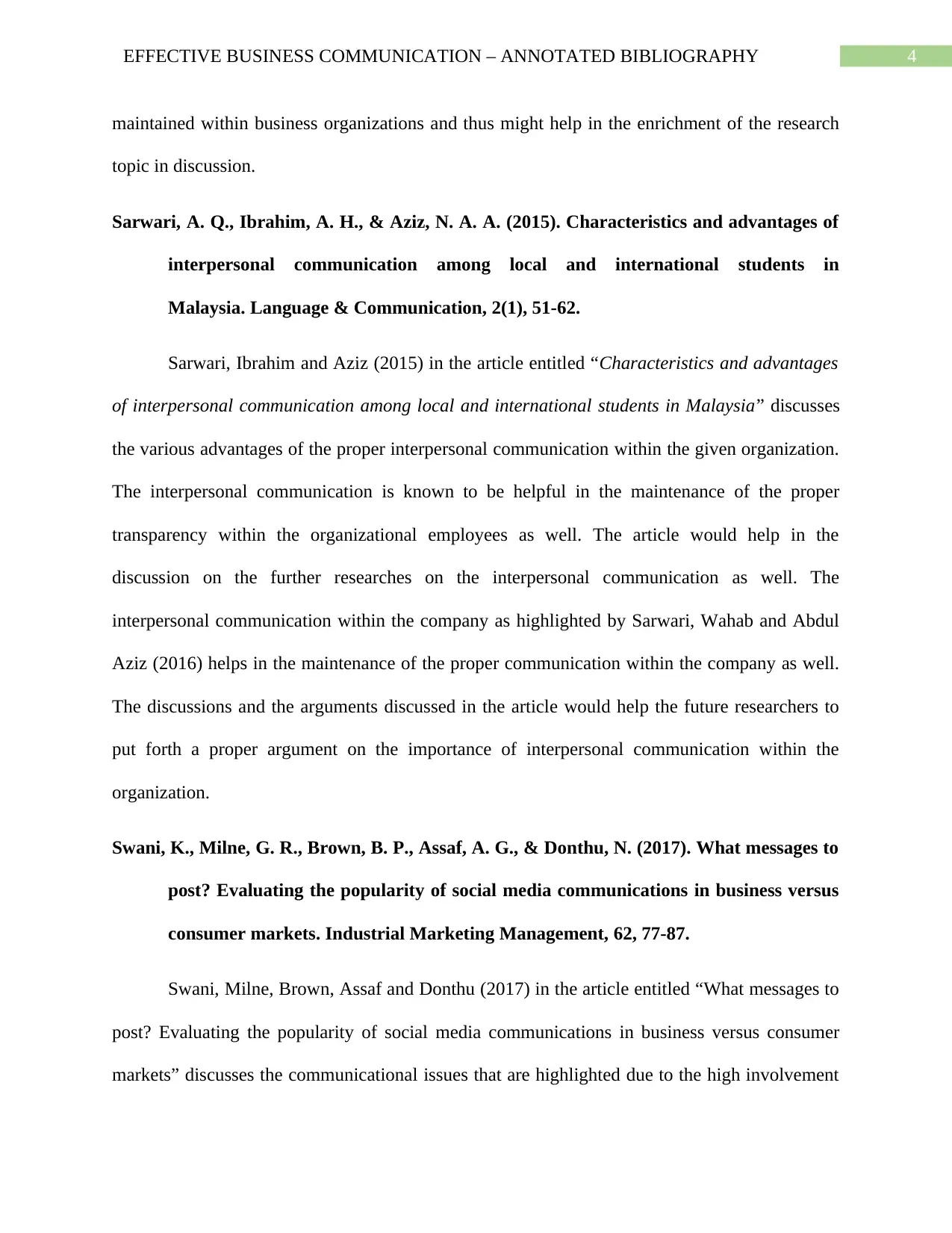
4EFFECTIVE BUSINESS COMMUNICATION – ANNOTATED BIBLIOGRAPHY
maintained within business organizations and thus might help in the enrichment of the research
topic in discussion.
Sarwari, A. Q., Ibrahim, A. H., & Aziz, N. A. A. (2015). Characteristics and advantages of
interpersonal communication among local and international students in
Malaysia. Language & Communication, 2(1), 51-62.
Sarwari, Ibrahim and Aziz (2015) in the article entitled “Characteristics and advantages
of interpersonal communication among local and international students in Malaysia” discusses
the various advantages of the proper interpersonal communication within the given organization.
The interpersonal communication is known to be helpful in the maintenance of the proper
transparency within the organizational employees as well. The article would help in the
discussion on the further researches on the interpersonal communication as well. The
interpersonal communication within the company as highlighted by Sarwari, Wahab and Abdul
Aziz (2016) helps in the maintenance of the proper communication within the company as well.
The discussions and the arguments discussed in the article would help the future researchers to
put forth a proper argument on the importance of interpersonal communication within the
organization.
Swani, K., Milne, G. R., Brown, B. P., Assaf, A. G., & Donthu, N. (2017). What messages to
post? Evaluating the popularity of social media communications in business versus
consumer markets. Industrial Marketing Management, 62, 77-87.
Swani, Milne, Brown, Assaf and Donthu (2017) in the article entitled “What messages to
post? Evaluating the popularity of social media communications in business versus consumer
markets” discusses the communicational issues that are highlighted due to the high involvement
maintained within business organizations and thus might help in the enrichment of the research
topic in discussion.
Sarwari, A. Q., Ibrahim, A. H., & Aziz, N. A. A. (2015). Characteristics and advantages of
interpersonal communication among local and international students in
Malaysia. Language & Communication, 2(1), 51-62.
Sarwari, Ibrahim and Aziz (2015) in the article entitled “Characteristics and advantages
of interpersonal communication among local and international students in Malaysia” discusses
the various advantages of the proper interpersonal communication within the given organization.
The interpersonal communication is known to be helpful in the maintenance of the proper
transparency within the organizational employees as well. The article would help in the
discussion on the further researches on the interpersonal communication as well. The
interpersonal communication within the company as highlighted by Sarwari, Wahab and Abdul
Aziz (2016) helps in the maintenance of the proper communication within the company as well.
The discussions and the arguments discussed in the article would help the future researchers to
put forth a proper argument on the importance of interpersonal communication within the
organization.
Swani, K., Milne, G. R., Brown, B. P., Assaf, A. G., & Donthu, N. (2017). What messages to
post? Evaluating the popularity of social media communications in business versus
consumer markets. Industrial Marketing Management, 62, 77-87.
Swani, Milne, Brown, Assaf and Donthu (2017) in the article entitled “What messages to
post? Evaluating the popularity of social media communications in business versus consumer
markets” discusses the communicational issues that are highlighted due to the high involvement
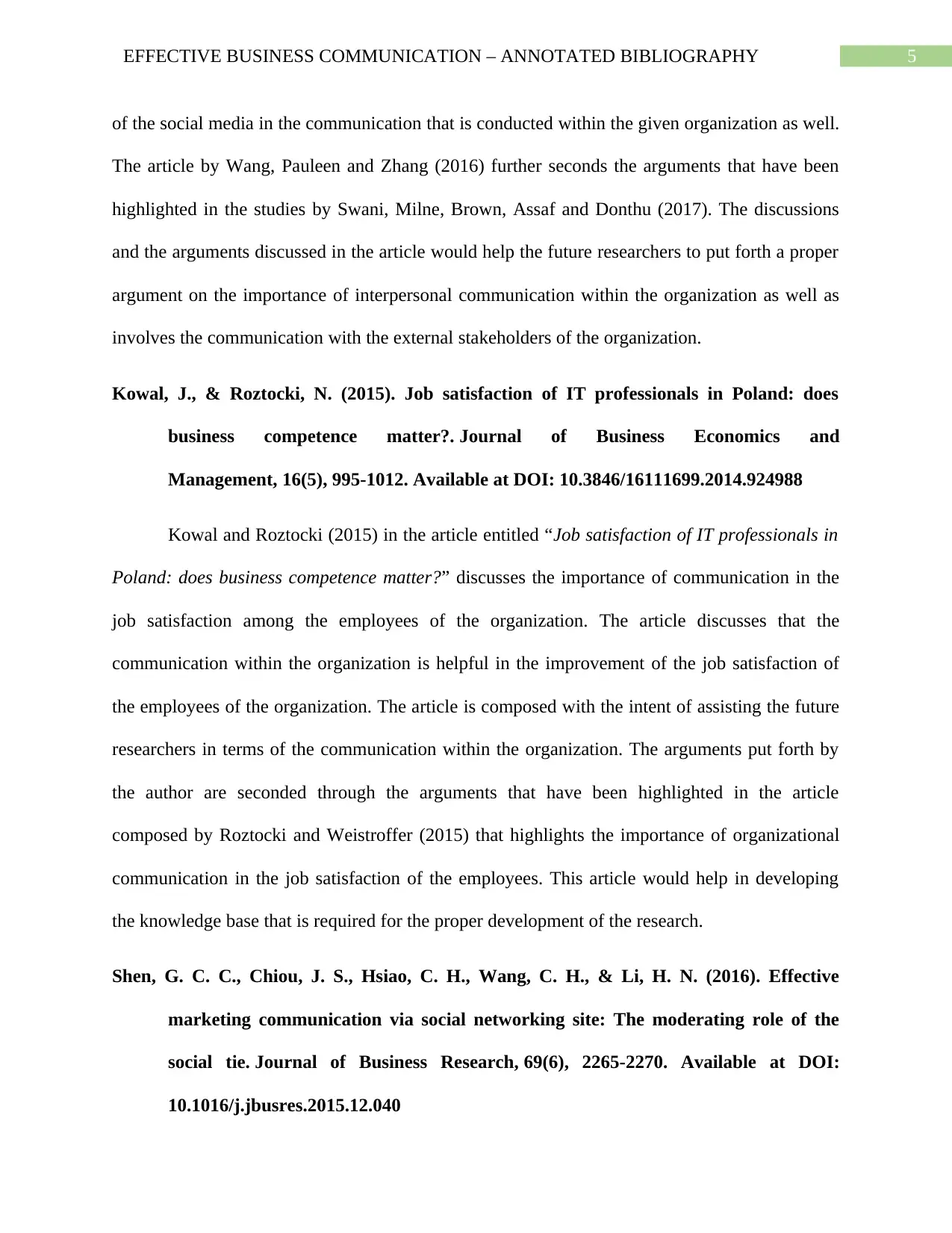
5EFFECTIVE BUSINESS COMMUNICATION – ANNOTATED BIBLIOGRAPHY
of the social media in the communication that is conducted within the given organization as well.
The article by Wang, Pauleen and Zhang (2016) further seconds the arguments that have been
highlighted in the studies by Swani, Milne, Brown, Assaf and Donthu (2017). The discussions
and the arguments discussed in the article would help the future researchers to put forth a proper
argument on the importance of interpersonal communication within the organization as well as
involves the communication with the external stakeholders of the organization.
Kowal, J., & Roztocki, N. (2015). Job satisfaction of IT professionals in Poland: does
business competence matter?. Journal of Business Economics and
Management, 16(5), 995-1012. Available at DOI: 10.3846/16111699.2014.924988
Kowal and Roztocki (2015) in the article entitled “Job satisfaction of IT professionals in
Poland: does business competence matter?” discusses the importance of communication in the
job satisfaction among the employees of the organization. The article discusses that the
communication within the organization is helpful in the improvement of the job satisfaction of
the employees of the organization. The article is composed with the intent of assisting the future
researchers in terms of the communication within the organization. The arguments put forth by
the author are seconded through the arguments that have been highlighted in the article
composed by Roztocki and Weistroffer (2015) that highlights the importance of organizational
communication in the job satisfaction of the employees. This article would help in developing
the knowledge base that is required for the proper development of the research.
Shen, G. C. C., Chiou, J. S., Hsiao, C. H., Wang, C. H., & Li, H. N. (2016). Effective
marketing communication via social networking site: The moderating role of the
social tie. Journal of Business Research, 69(6), 2265-2270. Available at DOI:
10.1016/j.jbusres.2015.12.040
of the social media in the communication that is conducted within the given organization as well.
The article by Wang, Pauleen and Zhang (2016) further seconds the arguments that have been
highlighted in the studies by Swani, Milne, Brown, Assaf and Donthu (2017). The discussions
and the arguments discussed in the article would help the future researchers to put forth a proper
argument on the importance of interpersonal communication within the organization as well as
involves the communication with the external stakeholders of the organization.
Kowal, J., & Roztocki, N. (2015). Job satisfaction of IT professionals in Poland: does
business competence matter?. Journal of Business Economics and
Management, 16(5), 995-1012. Available at DOI: 10.3846/16111699.2014.924988
Kowal and Roztocki (2015) in the article entitled “Job satisfaction of IT professionals in
Poland: does business competence matter?” discusses the importance of communication in the
job satisfaction among the employees of the organization. The article discusses that the
communication within the organization is helpful in the improvement of the job satisfaction of
the employees of the organization. The article is composed with the intent of assisting the future
researchers in terms of the communication within the organization. The arguments put forth by
the author are seconded through the arguments that have been highlighted in the article
composed by Roztocki and Weistroffer (2015) that highlights the importance of organizational
communication in the job satisfaction of the employees. This article would help in developing
the knowledge base that is required for the proper development of the research.
Shen, G. C. C., Chiou, J. S., Hsiao, C. H., Wang, C. H., & Li, H. N. (2016). Effective
marketing communication via social networking site: The moderating role of the
social tie. Journal of Business Research, 69(6), 2265-2270. Available at DOI:
10.1016/j.jbusres.2015.12.040
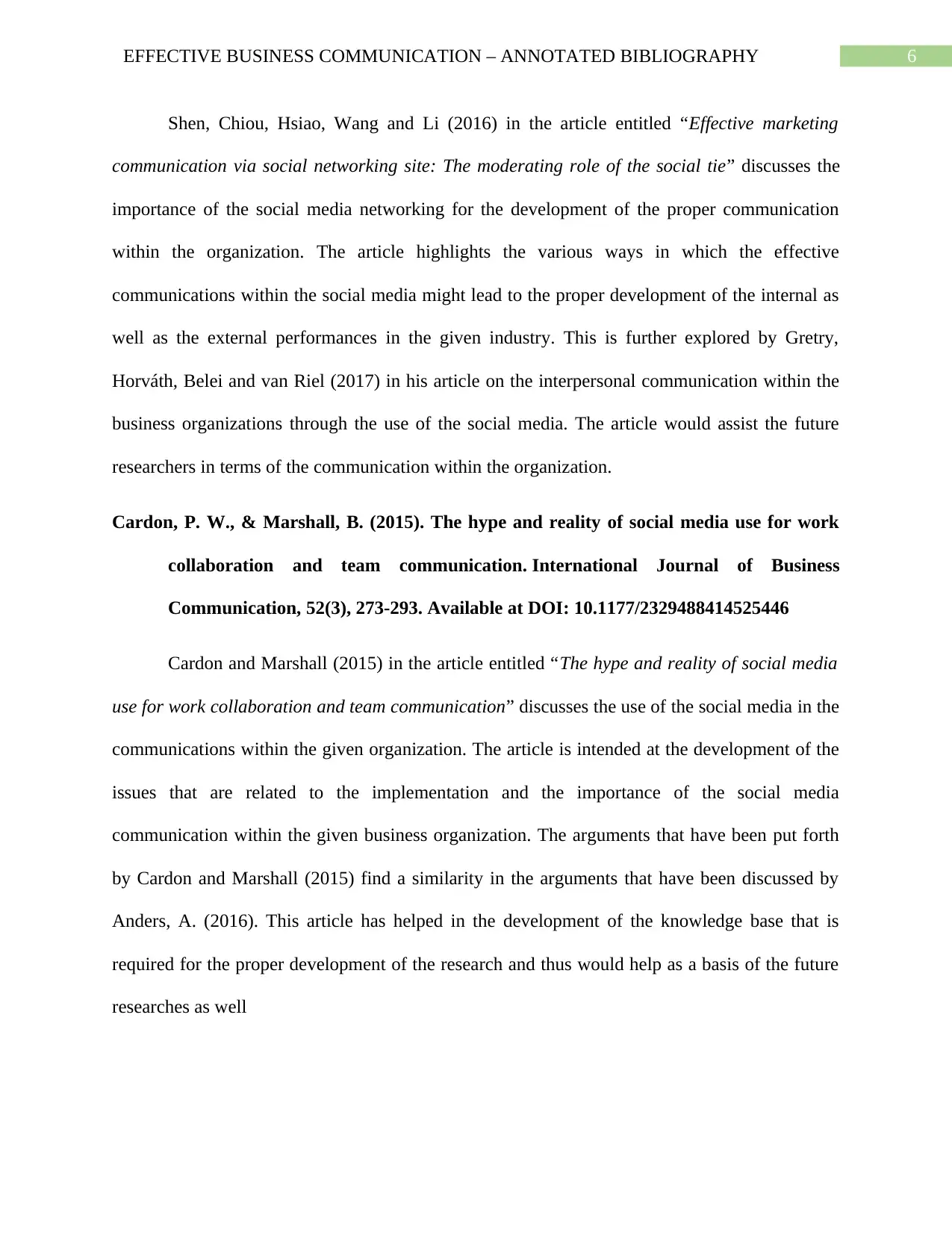
6EFFECTIVE BUSINESS COMMUNICATION – ANNOTATED BIBLIOGRAPHY
Shen, Chiou, Hsiao, Wang and Li (2016) in the article entitled “Effective marketing
communication via social networking site: The moderating role of the social tie” discusses the
importance of the social media networking for the development of the proper communication
within the organization. The article highlights the various ways in which the effective
communications within the social media might lead to the proper development of the internal as
well as the external performances in the given industry. This is further explored by Gretry,
Horváth, Belei and van Riel (2017) in his article on the interpersonal communication within the
business organizations through the use of the social media. The article would assist the future
researchers in terms of the communication within the organization.
Cardon, P. W., & Marshall, B. (2015). The hype and reality of social media use for work
collaboration and team communication. International Journal of Business
Communication, 52(3), 273-293. Available at DOI: 10.1177/2329488414525446
Cardon and Marshall (2015) in the article entitled “The hype and reality of social media
use for work collaboration and team communication” discusses the use of the social media in the
communications within the given organization. The article is intended at the development of the
issues that are related to the implementation and the importance of the social media
communication within the given business organization. The arguments that have been put forth
by Cardon and Marshall (2015) find a similarity in the arguments that have been discussed by
Anders, A. (2016). This article has helped in the development of the knowledge base that is
required for the proper development of the research and thus would help as a basis of the future
researches as well
Shen, Chiou, Hsiao, Wang and Li (2016) in the article entitled “Effective marketing
communication via social networking site: The moderating role of the social tie” discusses the
importance of the social media networking for the development of the proper communication
within the organization. The article highlights the various ways in which the effective
communications within the social media might lead to the proper development of the internal as
well as the external performances in the given industry. This is further explored by Gretry,
Horváth, Belei and van Riel (2017) in his article on the interpersonal communication within the
business organizations through the use of the social media. The article would assist the future
researchers in terms of the communication within the organization.
Cardon, P. W., & Marshall, B. (2015). The hype and reality of social media use for work
collaboration and team communication. International Journal of Business
Communication, 52(3), 273-293. Available at DOI: 10.1177/2329488414525446
Cardon and Marshall (2015) in the article entitled “The hype and reality of social media
use for work collaboration and team communication” discusses the use of the social media in the
communications within the given organization. The article is intended at the development of the
issues that are related to the implementation and the importance of the social media
communication within the given business organization. The arguments that have been put forth
by Cardon and Marshall (2015) find a similarity in the arguments that have been discussed by
Anders, A. (2016). This article has helped in the development of the knowledge base that is
required for the proper development of the research and thus would help as a basis of the future
researches as well
Paraphrase This Document
Need a fresh take? Get an instant paraphrase of this document with our AI Paraphraser
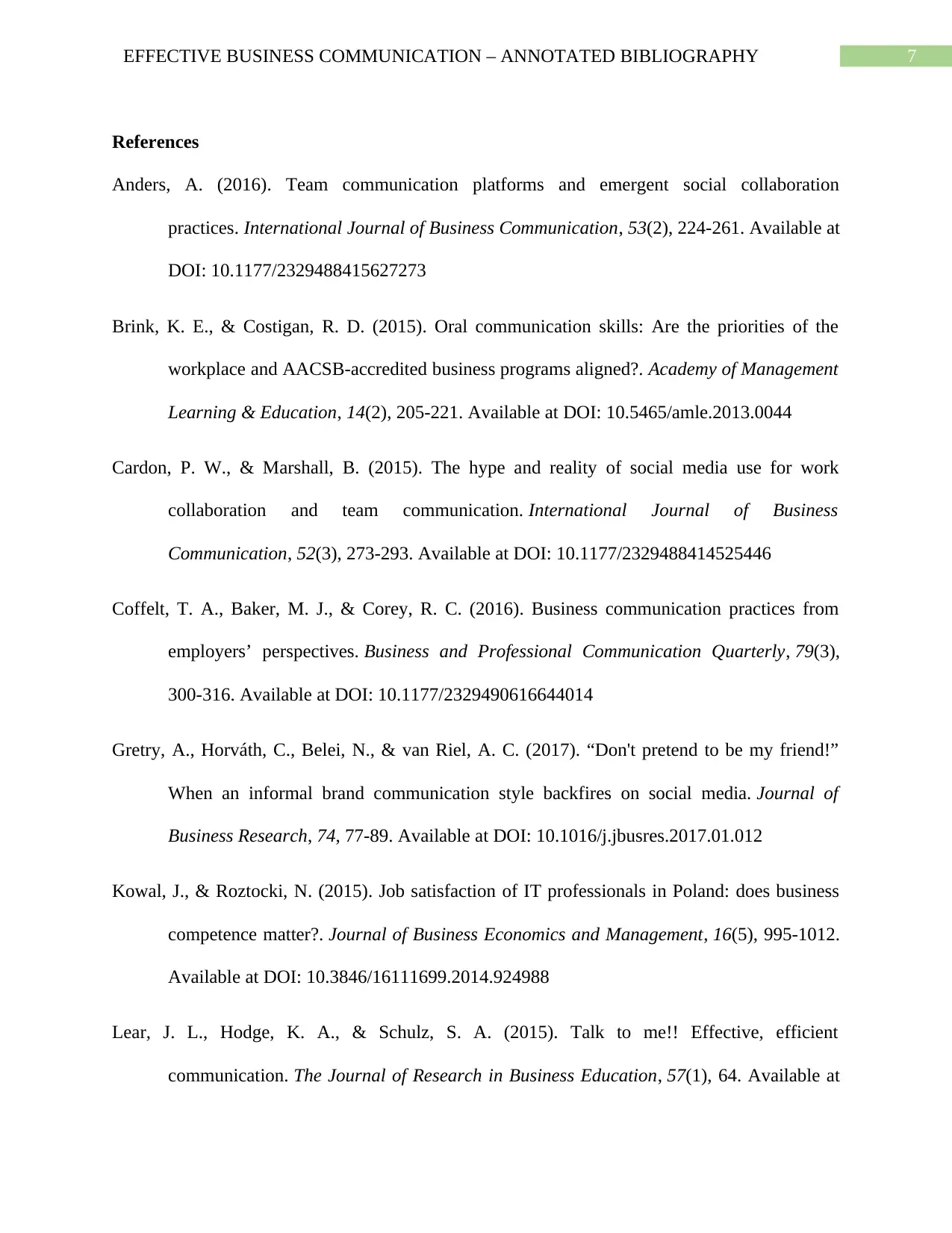
7EFFECTIVE BUSINESS COMMUNICATION – ANNOTATED BIBLIOGRAPHY
References
Anders, A. (2016). Team communication platforms and emergent social collaboration
practices. International Journal of Business Communication, 53(2), 224-261. Available at
DOI: 10.1177/2329488415627273
Brink, K. E., & Costigan, R. D. (2015). Oral communication skills: Are the priorities of the
workplace and AACSB-accredited business programs aligned?. Academy of Management
Learning & Education, 14(2), 205-221. Available at DOI: 10.5465/amle.2013.0044
Cardon, P. W., & Marshall, B. (2015). The hype and reality of social media use for work
collaboration and team communication. International Journal of Business
Communication, 52(3), 273-293. Available at DOI: 10.1177/2329488414525446
Coffelt, T. A., Baker, M. J., & Corey, R. C. (2016). Business communication practices from
employers’ perspectives. Business and Professional Communication Quarterly, 79(3),
300-316. Available at DOI: 10.1177/2329490616644014
Gretry, A., Horváth, C., Belei, N., & van Riel, A. C. (2017). “Don't pretend to be my friend!”
When an informal brand communication style backfires on social media. Journal of
Business Research, 74, 77-89. Available at DOI: 10.1016/j.jbusres.2017.01.012
Kowal, J., & Roztocki, N. (2015). Job satisfaction of IT professionals in Poland: does business
competence matter?. Journal of Business Economics and Management, 16(5), 995-1012.
Available at DOI: 10.3846/16111699.2014.924988
Lear, J. L., Hodge, K. A., & Schulz, S. A. (2015). Talk to me!! Effective, efficient
communication. The Journal of Research in Business Education, 57(1), 64. Available at
References
Anders, A. (2016). Team communication platforms and emergent social collaboration
practices. International Journal of Business Communication, 53(2), 224-261. Available at
DOI: 10.1177/2329488415627273
Brink, K. E., & Costigan, R. D. (2015). Oral communication skills: Are the priorities of the
workplace and AACSB-accredited business programs aligned?. Academy of Management
Learning & Education, 14(2), 205-221. Available at DOI: 10.5465/amle.2013.0044
Cardon, P. W., & Marshall, B. (2015). The hype and reality of social media use for work
collaboration and team communication. International Journal of Business
Communication, 52(3), 273-293. Available at DOI: 10.1177/2329488414525446
Coffelt, T. A., Baker, M. J., & Corey, R. C. (2016). Business communication practices from
employers’ perspectives. Business and Professional Communication Quarterly, 79(3),
300-316. Available at DOI: 10.1177/2329490616644014
Gretry, A., Horváth, C., Belei, N., & van Riel, A. C. (2017). “Don't pretend to be my friend!”
When an informal brand communication style backfires on social media. Journal of
Business Research, 74, 77-89. Available at DOI: 10.1016/j.jbusres.2017.01.012
Kowal, J., & Roztocki, N. (2015). Job satisfaction of IT professionals in Poland: does business
competence matter?. Journal of Business Economics and Management, 16(5), 995-1012.
Available at DOI: 10.3846/16111699.2014.924988
Lear, J. L., Hodge, K. A., & Schulz, S. A. (2015). Talk to me!! Effective, efficient
communication. The Journal of Research in Business Education, 57(1), 64. Available at
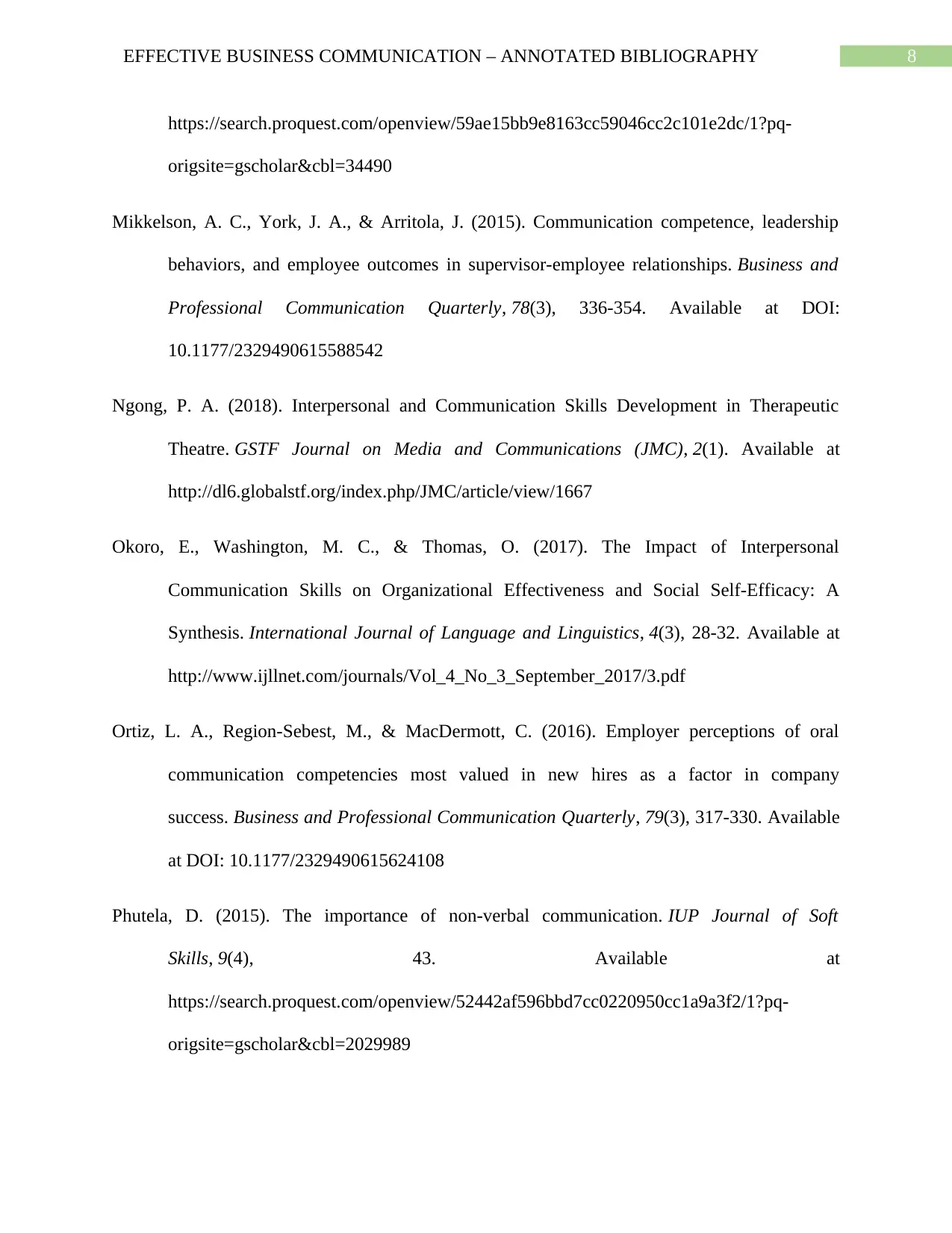
8EFFECTIVE BUSINESS COMMUNICATION – ANNOTATED BIBLIOGRAPHY
https://search.proquest.com/openview/59ae15bb9e8163cc59046cc2c101e2dc/1?pq-
origsite=gscholar&cbl=34490
Mikkelson, A. C., York, J. A., & Arritola, J. (2015). Communication competence, leadership
behaviors, and employee outcomes in supervisor-employee relationships. Business and
Professional Communication Quarterly, 78(3), 336-354. Available at DOI:
10.1177/2329490615588542
Ngong, P. A. (2018). Interpersonal and Communication Skills Development in Therapeutic
Theatre. GSTF Journal on Media and Communications (JMC), 2(1). Available at
http://dl6.globalstf.org/index.php/JMC/article/view/1667
Okoro, E., Washington, M. C., & Thomas, O. (2017). The Impact of Interpersonal
Communication Skills on Organizational Effectiveness and Social Self-Efficacy: A
Synthesis. International Journal of Language and Linguistics, 4(3), 28-32. Available at
http://www.ijllnet.com/journals/Vol_4_No_3_September_2017/3.pdf
Ortiz, L. A., Region-Sebest, M., & MacDermott, C. (2016). Employer perceptions of oral
communication competencies most valued in new hires as a factor in company
success. Business and Professional Communication Quarterly, 79(3), 317-330. Available
at DOI: 10.1177/2329490615624108
Phutela, D. (2015). The importance of non-verbal communication. IUP Journal of Soft
Skills, 9(4), 43. Available at
https://search.proquest.com/openview/52442af596bbd7cc0220950cc1a9a3f2/1?pq-
origsite=gscholar&cbl=2029989
https://search.proquest.com/openview/59ae15bb9e8163cc59046cc2c101e2dc/1?pq-
origsite=gscholar&cbl=34490
Mikkelson, A. C., York, J. A., & Arritola, J. (2015). Communication competence, leadership
behaviors, and employee outcomes in supervisor-employee relationships. Business and
Professional Communication Quarterly, 78(3), 336-354. Available at DOI:
10.1177/2329490615588542
Ngong, P. A. (2018). Interpersonal and Communication Skills Development in Therapeutic
Theatre. GSTF Journal on Media and Communications (JMC), 2(1). Available at
http://dl6.globalstf.org/index.php/JMC/article/view/1667
Okoro, E., Washington, M. C., & Thomas, O. (2017). The Impact of Interpersonal
Communication Skills on Organizational Effectiveness and Social Self-Efficacy: A
Synthesis. International Journal of Language and Linguistics, 4(3), 28-32. Available at
http://www.ijllnet.com/journals/Vol_4_No_3_September_2017/3.pdf
Ortiz, L. A., Region-Sebest, M., & MacDermott, C. (2016). Employer perceptions of oral
communication competencies most valued in new hires as a factor in company
success. Business and Professional Communication Quarterly, 79(3), 317-330. Available
at DOI: 10.1177/2329490615624108
Phutela, D. (2015). The importance of non-verbal communication. IUP Journal of Soft
Skills, 9(4), 43. Available at
https://search.proquest.com/openview/52442af596bbd7cc0220950cc1a9a3f2/1?pq-
origsite=gscholar&cbl=2029989
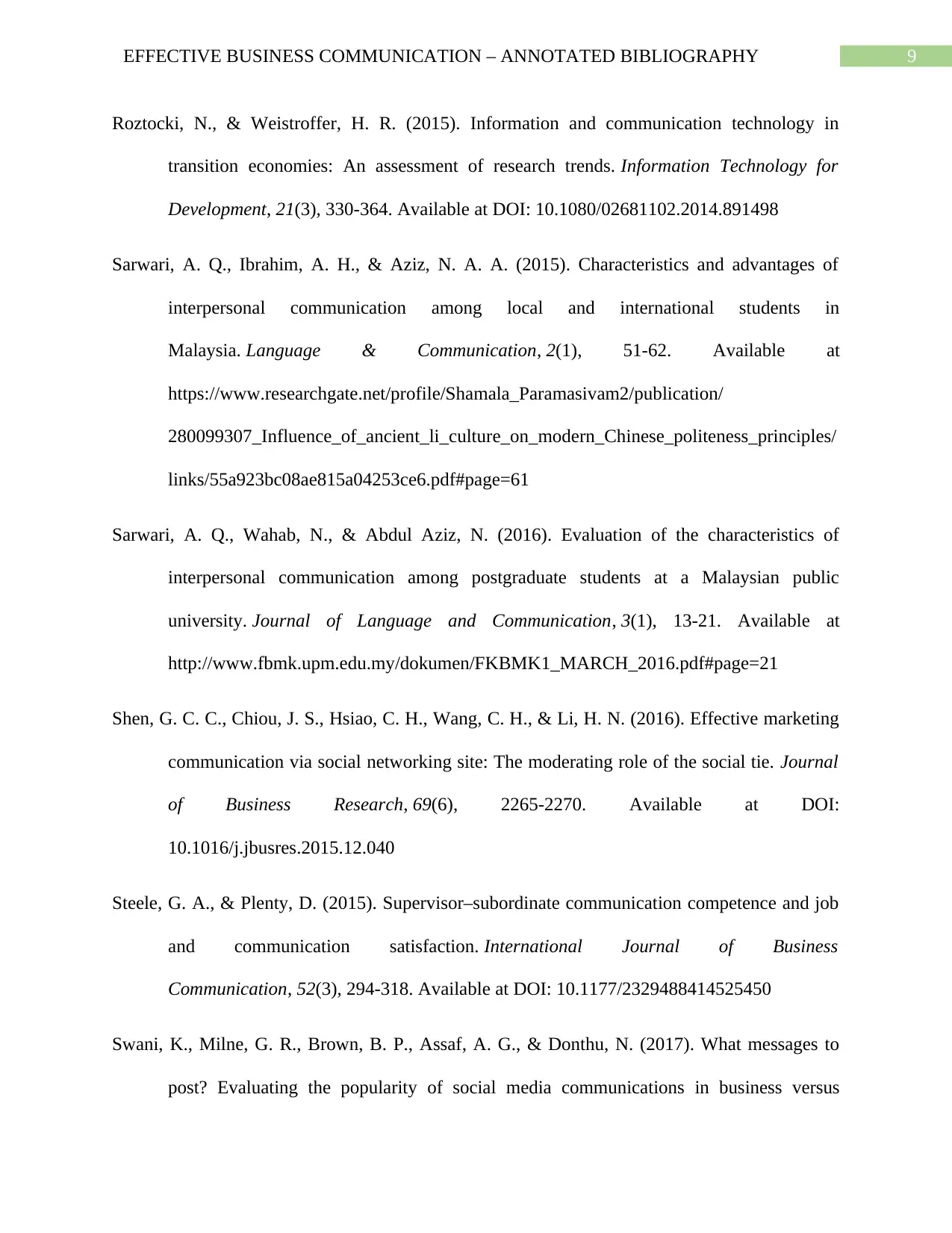
9EFFECTIVE BUSINESS COMMUNICATION – ANNOTATED BIBLIOGRAPHY
Roztocki, N., & Weistroffer, H. R. (2015). Information and communication technology in
transition economies: An assessment of research trends. Information Technology for
Development, 21(3), 330-364. Available at DOI: 10.1080/02681102.2014.891498
Sarwari, A. Q., Ibrahim, A. H., & Aziz, N. A. A. (2015). Characteristics and advantages of
interpersonal communication among local and international students in
Malaysia. Language & Communication, 2(1), 51-62. Available at
https://www.researchgate.net/profile/Shamala_Paramasivam2/publication/
280099307_Influence_of_ancient_li_culture_on_modern_Chinese_politeness_principles/
links/55a923bc08ae815a04253ce6.pdf#page=61
Sarwari, A. Q., Wahab, N., & Abdul Aziz, N. (2016). Evaluation of the characteristics of
interpersonal communication among postgraduate students at a Malaysian public
university. Journal of Language and Communication, 3(1), 13-21. Available at
http://www.fbmk.upm.edu.my/dokumen/FKBMK1_MARCH_2016.pdf#page=21
Shen, G. C. C., Chiou, J. S., Hsiao, C. H., Wang, C. H., & Li, H. N. (2016). Effective marketing
communication via social networking site: The moderating role of the social tie. Journal
of Business Research, 69(6), 2265-2270. Available at DOI:
10.1016/j.jbusres.2015.12.040
Steele, G. A., & Plenty, D. (2015). Supervisor–subordinate communication competence and job
and communication satisfaction. International Journal of Business
Communication, 52(3), 294-318. Available at DOI: 10.1177/2329488414525450
Swani, K., Milne, G. R., Brown, B. P., Assaf, A. G., & Donthu, N. (2017). What messages to
post? Evaluating the popularity of social media communications in business versus
Roztocki, N., & Weistroffer, H. R. (2015). Information and communication technology in
transition economies: An assessment of research trends. Information Technology for
Development, 21(3), 330-364. Available at DOI: 10.1080/02681102.2014.891498
Sarwari, A. Q., Ibrahim, A. H., & Aziz, N. A. A. (2015). Characteristics and advantages of
interpersonal communication among local and international students in
Malaysia. Language & Communication, 2(1), 51-62. Available at
https://www.researchgate.net/profile/Shamala_Paramasivam2/publication/
280099307_Influence_of_ancient_li_culture_on_modern_Chinese_politeness_principles/
links/55a923bc08ae815a04253ce6.pdf#page=61
Sarwari, A. Q., Wahab, N., & Abdul Aziz, N. (2016). Evaluation of the characteristics of
interpersonal communication among postgraduate students at a Malaysian public
university. Journal of Language and Communication, 3(1), 13-21. Available at
http://www.fbmk.upm.edu.my/dokumen/FKBMK1_MARCH_2016.pdf#page=21
Shen, G. C. C., Chiou, J. S., Hsiao, C. H., Wang, C. H., & Li, H. N. (2016). Effective marketing
communication via social networking site: The moderating role of the social tie. Journal
of Business Research, 69(6), 2265-2270. Available at DOI:
10.1016/j.jbusres.2015.12.040
Steele, G. A., & Plenty, D. (2015). Supervisor–subordinate communication competence and job
and communication satisfaction. International Journal of Business
Communication, 52(3), 294-318. Available at DOI: 10.1177/2329488414525450
Swani, K., Milne, G. R., Brown, B. P., Assaf, A. G., & Donthu, N. (2017). What messages to
post? Evaluating the popularity of social media communications in business versus
Secure Best Marks with AI Grader
Need help grading? Try our AI Grader for instant feedback on your assignments.
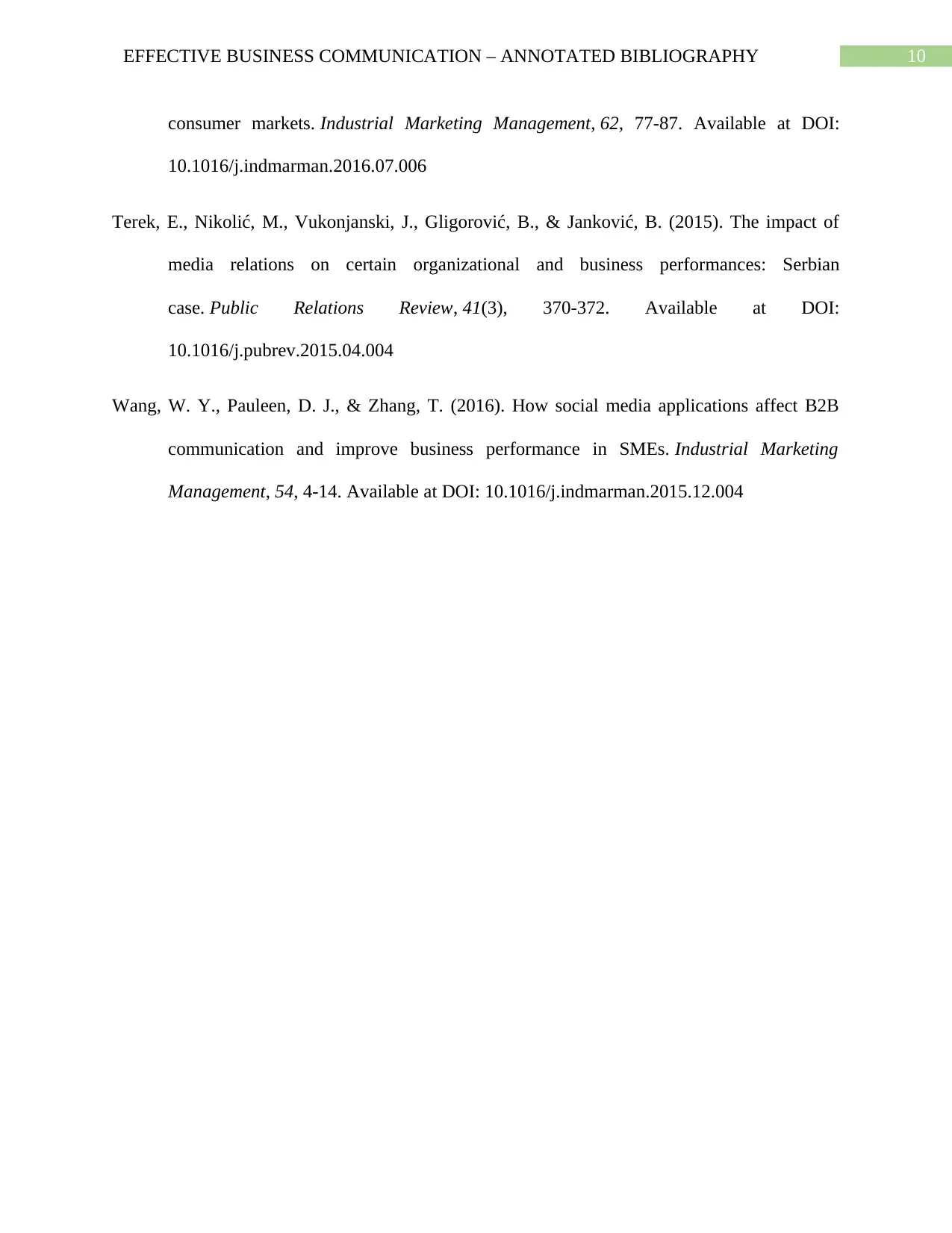
10EFFECTIVE BUSINESS COMMUNICATION – ANNOTATED BIBLIOGRAPHY
consumer markets. Industrial Marketing Management, 62, 77-87. Available at DOI:
10.1016/j.indmarman.2016.07.006
Terek, E., Nikolić, M., Vukonjanski, J., Gligorović, B., & Janković, B. (2015). The impact of
media relations on certain organizational and business performances: Serbian
case. Public Relations Review, 41(3), 370-372. Available at DOI:
10.1016/j.pubrev.2015.04.004
Wang, W. Y., Pauleen, D. J., & Zhang, T. (2016). How social media applications affect B2B
communication and improve business performance in SMEs. Industrial Marketing
Management, 54, 4-14. Available at DOI: 10.1016/j.indmarman.2015.12.004
consumer markets. Industrial Marketing Management, 62, 77-87. Available at DOI:
10.1016/j.indmarman.2016.07.006
Terek, E., Nikolić, M., Vukonjanski, J., Gligorović, B., & Janković, B. (2015). The impact of
media relations on certain organizational and business performances: Serbian
case. Public Relations Review, 41(3), 370-372. Available at DOI:
10.1016/j.pubrev.2015.04.004
Wang, W. Y., Pauleen, D. J., & Zhang, T. (2016). How social media applications affect B2B
communication and improve business performance in SMEs. Industrial Marketing
Management, 54, 4-14. Available at DOI: 10.1016/j.indmarman.2015.12.004
1 out of 11
Related Documents
Your All-in-One AI-Powered Toolkit for Academic Success.
+13062052269
info@desklib.com
Available 24*7 on WhatsApp / Email
![[object Object]](/_next/static/media/star-bottom.7253800d.svg)
Unlock your academic potential
© 2024 | Zucol Services PVT LTD | All rights reserved.



